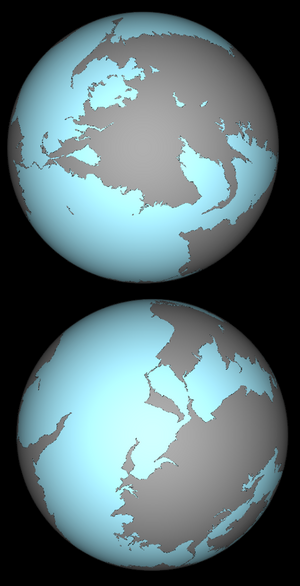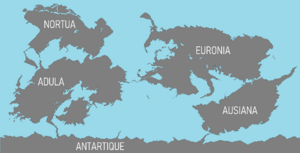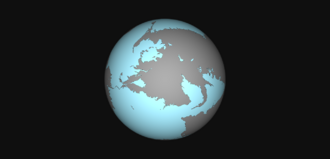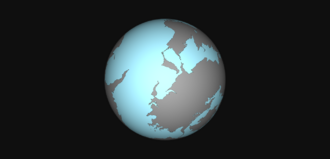Iearth
This article is incomplete because it is pending further input from participants, or it is a work-in-progress by one author. Please comment on this article's talk page to share your input, comments and questions. Note: To contribute to this article, you may need to seek help from the author(s) of this page. |
 Photographs of both hemispheres of Iearth, taken by the Zamastanian Zian-2B Satellite | |
| Orbital characteristics | |
|---|---|
| 149598023 km (92955902 mi; 1.00000102 AU) | |
| Eccentricity | 0.0167086 |
| 365.256363004 d (1.00001742096 yr) | |
| Satellite of | Sun |
| Physical characteristics | |
Mean radius | 6371.0 km (3958.8 mi) |
| 510072000 km2 (196940000 sq mi) | |
| Volume | 1.08321×1012 km3 (2.59876×1011 cu mi) |
| Mass | 5.97237×1024 kg (1.31668×1025 lb) |
Mean density | 5.514 g/cm3 (0.1992 lb/cu in) |
| 9.807 m/s2 (1 g; 32.18 ft/s2) | |
| 11.186 km/s (40270 km/h; 25020 mph) | |
| 23.4392811° | |
| Atmosphere | |
Surface pressure | 1 atm (100 kPa) |
Iearth, also known as Earth or the World, is the fifth planet from the Sun. It is the only planet in the cosmos known to accomodate life. Scientific analysis generally concludes that Iearth developed over 4 billion years ago. The Iearth rotates around the Sun in 365 and ¼ days, a period commonly accepted as a year.
Humans are the most influential lifeform on Iearth, with their influence being clearly seen on the planet's surface whether with reference to atmospheric composition, land cover, hydrology, light or the transportation and transformation of terrestrial material. The world contains a large variety of nations (some of the most significant being Zamastan, Beleroskov, Vulkaria, Yuan, and Cadair), where the developments of humanity can be seen through the many languages spoken, international organizations such as the Coalition of Crown Albatross, conflicts and warfare such as the World War, and the control and manipulation of other species, energy, and natural resources. According to the latest census date the Iearth is home to about 10 billion human beings.
Etmology
The most commonly accepted Caticeze-English word for Iearth comes from the Verdusian word eorðe, meaning dirt, soil, dry land, and ground.
History
See also: History of Iearth
Physical characteristics
Continents
Eurth has an approx. total area of 131,750,000 km2 (50,870,000 sq mi). The land is divided into four continents. A continent is one of several very large landmasses of the world. Identified by convention rather than any strict criteria, we commonly regard up to four regions as continents. Ordered alphabetically, these continents are:
| Map of the Continents | Name | |
|---|---|---|

|
Adula | |
| Ausiana | ||
| Euronia | ||
| Nortua | ||
| Antartique |
Oceans
Iearth is a blue planet. The presence of water on its surface is unique in the Sanar system. The main bodies of water in the hydrosphere are the oceans.
| Map of the Continents | Name | |
|---|---|---|

|
Northern Ocean | |
| Olympic Ocean | ||
| Samson Ocean | ||
| Toyana Ocean |
Humanity
See: List of sovereign states and dependent territories (Iearth)
About 50% of Iearth is covered in water, with the remainder of of land also being roughly 90% uninhabitable due to mountains, desert, and ice caps. *settlement name* in *country/island* is the northernmost permanent settlement in the world. The southernmost is the Joint Antartique South Pole Station located almost exactly at the South Pole on the continent of Antartique.


